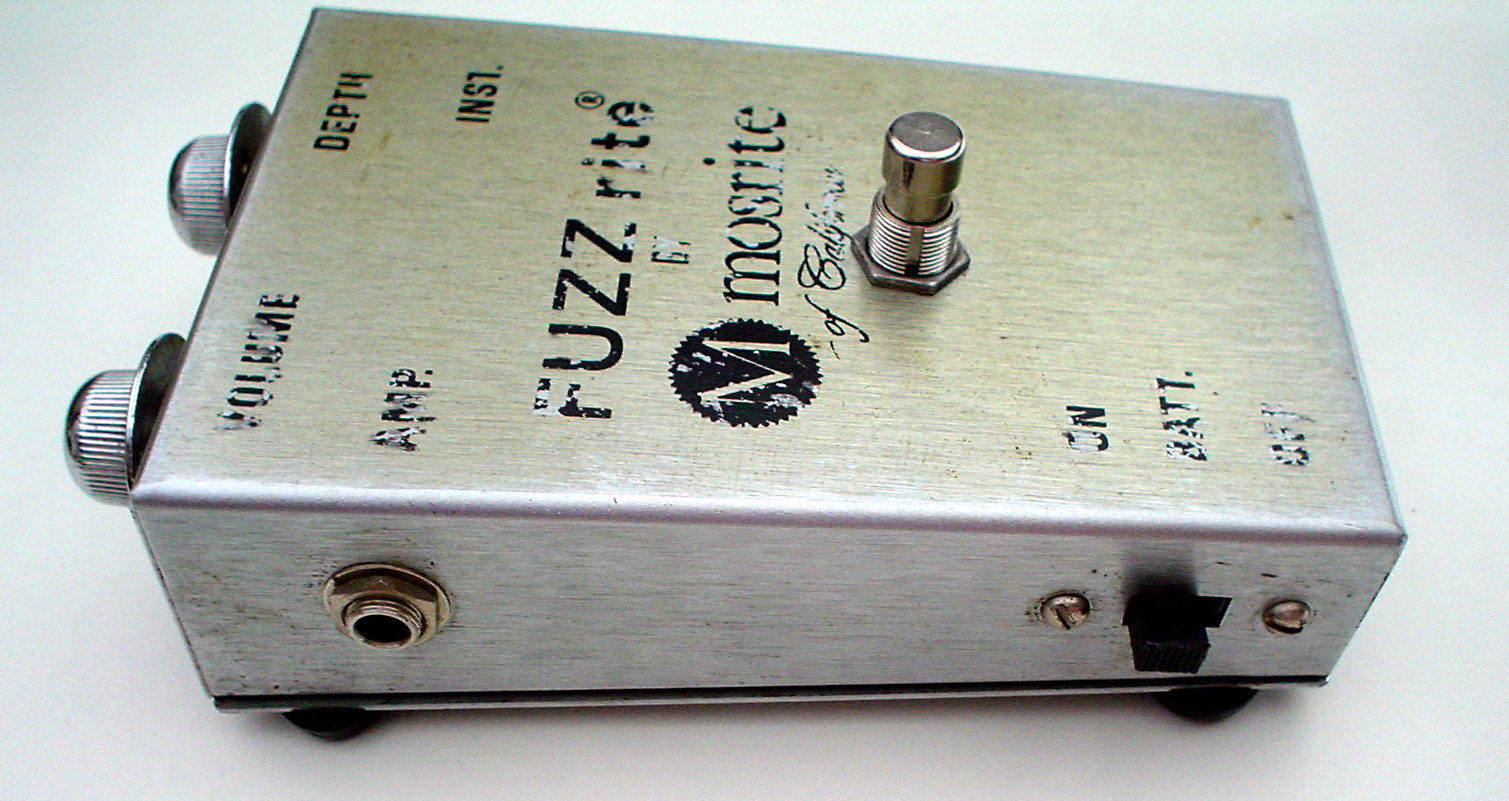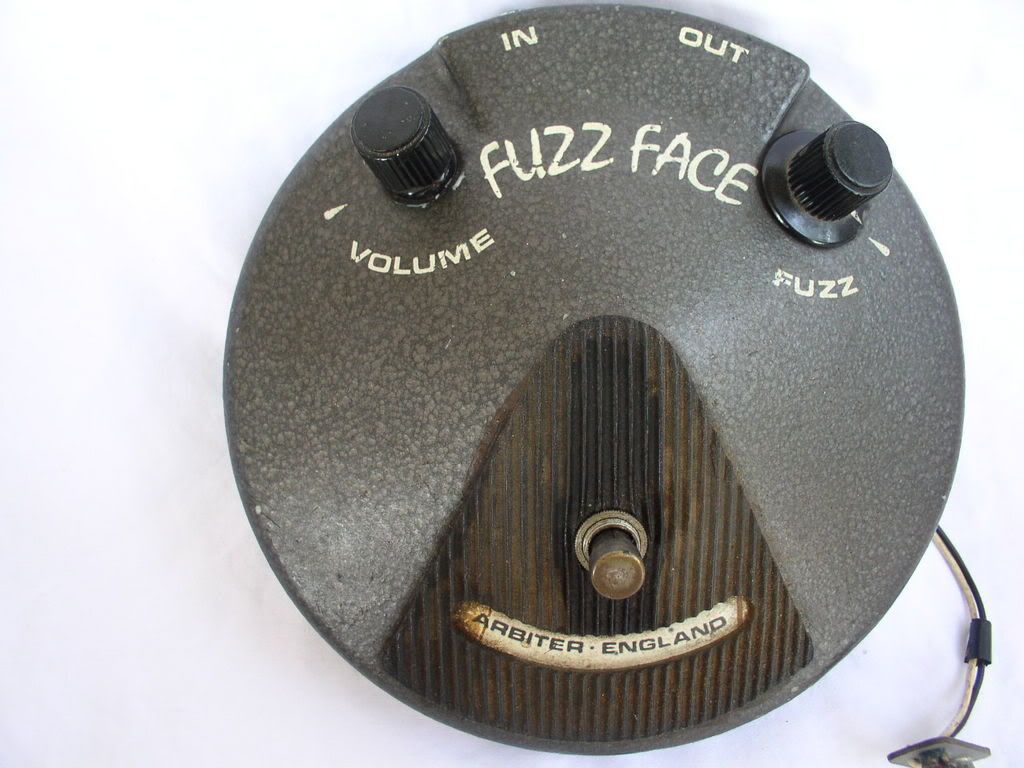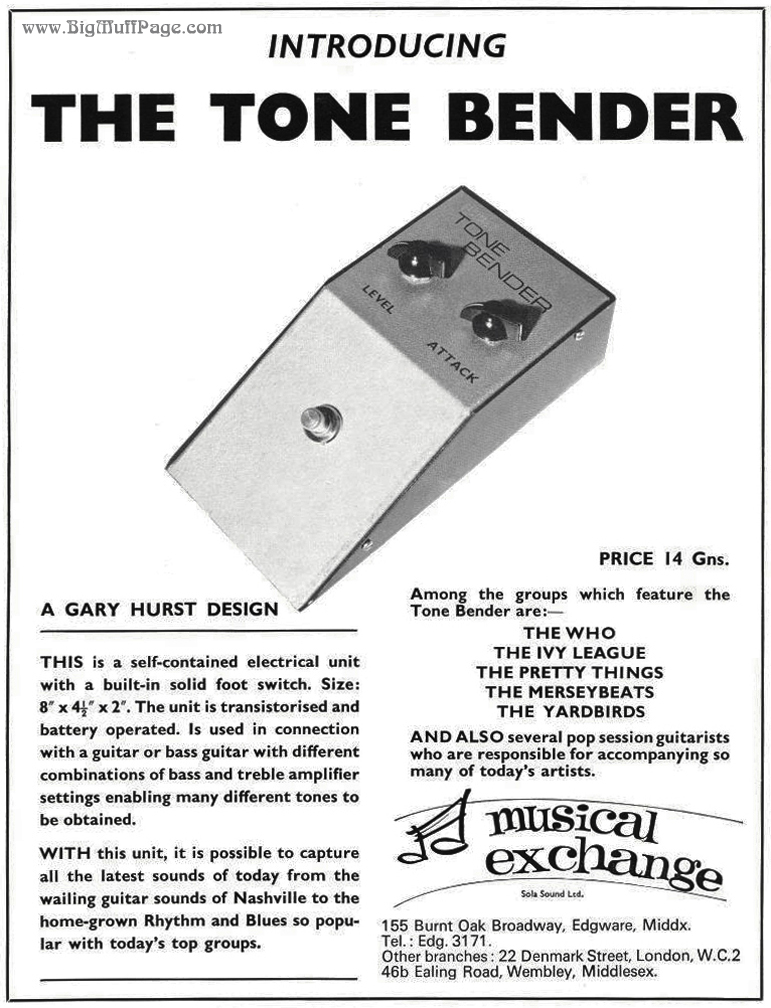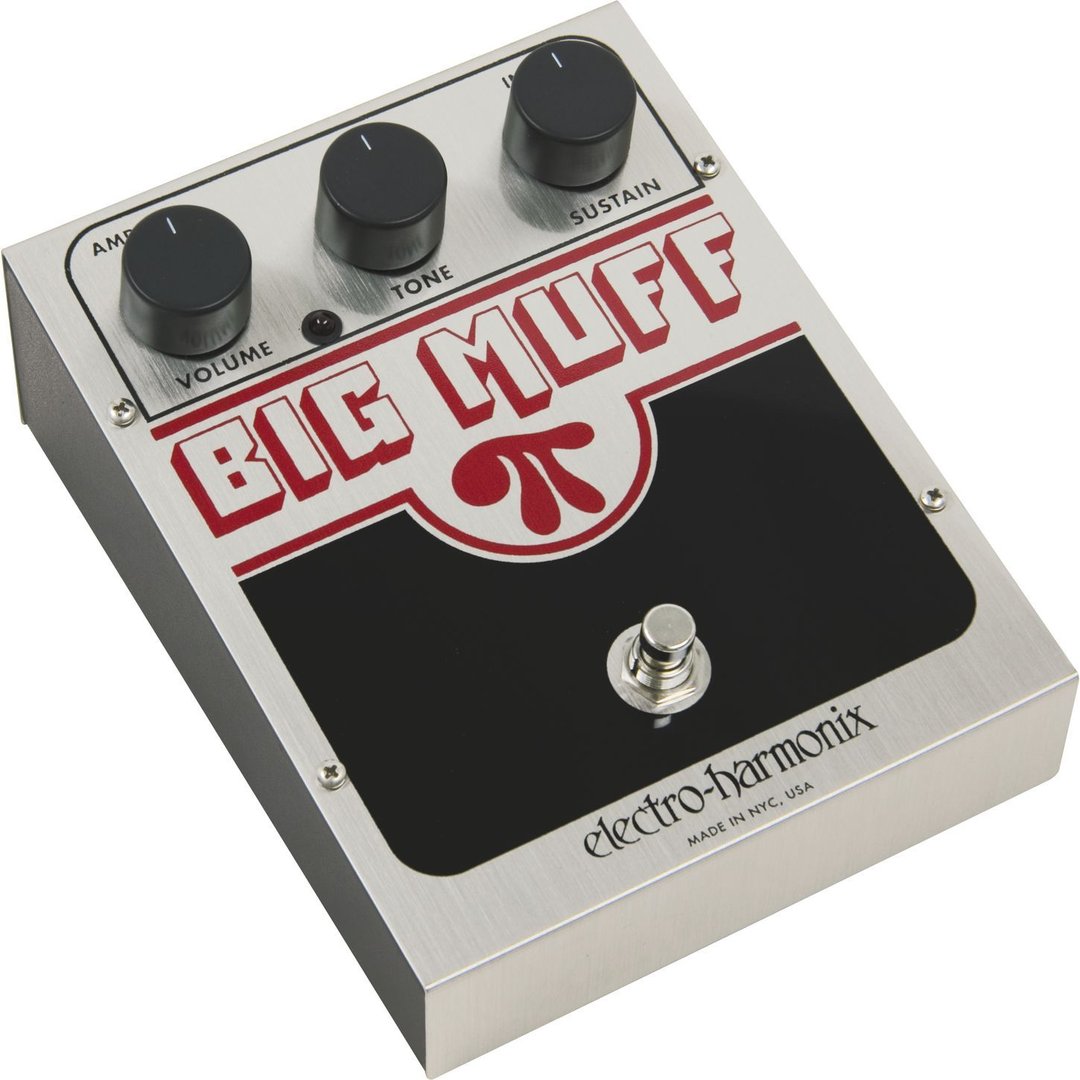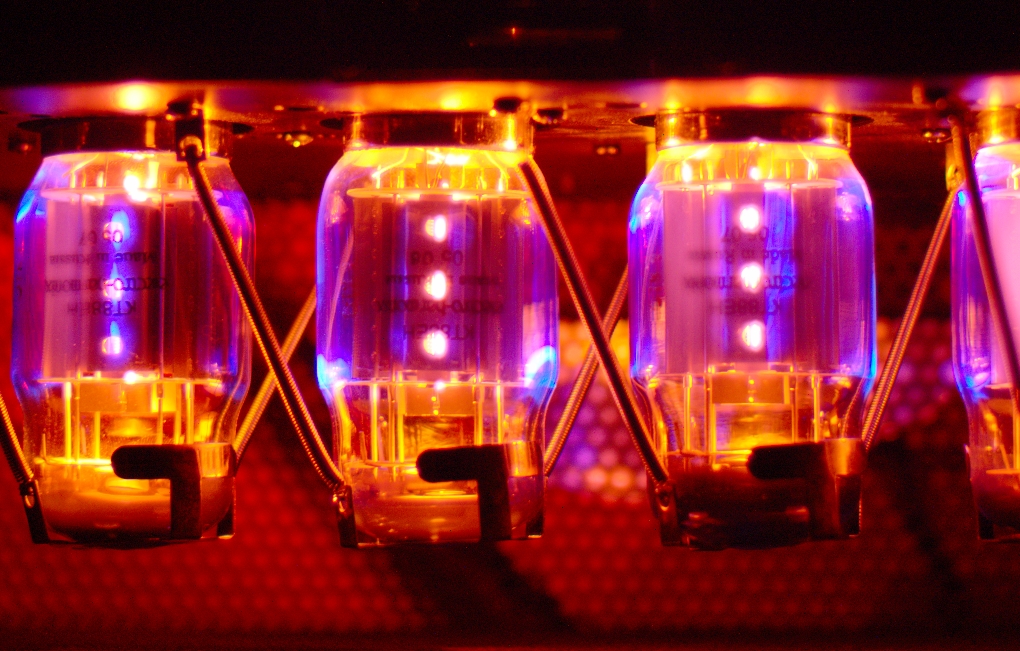
Distortion and overdrive are "gain" effects used to alter the sound of amplified electric musical instruments, most commonly with the electric guitar but also with other electric instruments. Blues guitarists playing electric blues originally obtained an overdrive sound by turning up their vacuum tube-powered guitar amplifiers to high volumes. While overdriven tube amps are still used to obtain overdrive in the 2010s, especially in genres like blues and rock, since the 1960s, a number of other ways to produce distortion have been developed, such as distortion effect pedals.
The effects alter the instrument sound by clipping the signal, which adds sustain and harmonic and inharmonic overtones, leading to a compressed sound that is often described as "warm" and "dirty" depending on the type and intensity of distortion used. The effects are popular with electric guitar players in the blues, rock, heavy metal and punk rock genres. The terms distortion and overdrive are often used interchangeably: where a distinction is made, "distortion" is used to denote a more extreme version of the effect than "overdrive". Fuzz is a term used to describe a particular form of distortion, originally created by guitarists using faulty equipment (such as a misaligned valve tube, see below), which has been emulated since the 1960s by a number of "fuzzbox" effects pedals.
Distortion, overdrive, and fuzz, can be produced by effects pedals, rackmounts, pre-amplifiers, power amplifiers, speakers and since the 2000s, digital amplifier modeling devices and audio software.[1][2] These effects are used with electric guitars, electric basses (fuzz bass), electronic keyboards, and more rarely, as a special effect, with vocals. While almost all of this article deals with the use of intentional distortion created for a musical effect, a section below describes some musical applications where musicians and sound engineers usually take steps to avoid distortion (e.g., with PA system vocals and the playback of prerecorded music).
The word distortion refers to any modification of wave form of a signal, but in music it is used to refer to nonlinear distortion (excluding filters) and particularly to the introduction of new frequencies by memoryless nonlinearities.[30] In music the different forms of linear distortion have specific names describing them. The simplest of these is a distortion process known as "volume adjustment", which involves distorting the amplitude of a sound wave in a proportional (or ‘linear’) way in order to increase or decrease the volume of the sound without affecting the tone quality. In the context of music, the most common source of (nonlinear) distortion is clipping in amplifier circuits and is most commonly known as overdrive.
Clipping is a non-linear process that produces frequencies not originally present in the audio signal. These frequencies can be harmonic overtones, meaning they are whole number multiples of one of the signal's original frequencies, or "inharmonic", resulting from general intermodulation distortion. The same nonlinear device will produce both types of distortion, depending on the input signal. Intermodulation occurs whenever the input frequencies are not already harmonically related. For instance, playing a power chord through distortion results in intermodulation that produces new subharmonics.
"Soft clipping" gradually flattens the peaks of a signal and de-emphasizes higher harmonics. "Hard clipping" flattens peaks abruptly, resulting in higher power in the higher harmonics. This is generally described as sounding "harsh".
The guitar solo on Chuck Berry's 1955 single "Maybellene" features "warm" overtone distortion produced by an inexpensive valve amplifier.
The first amplifiers built for electric guitar were relatively low-fidelity, and would often produce distortion when their volume (gain) was increased beyond their design limit or if they sustained minor damage.
Distortion and Overdrive circuits each 'clip' the signal before it reaches the main amplifier (a Clean Boost circuits do not create 'clipping') as well as boost signals to levels that cause distortion to occur at the main amplifier's front end stage (by exceeding the ordinary input signal amplitude, thus overdriving the amplifier) [Note : product names may not accurately reflect type of circuit involved - see above.
A fuzz box alters an audio signal until it is nearly a square wave and adds complex overtones by way of a frequency multiplier.
Around 1945 Western-swing guitarist Junior Barnard began experimenting with a rudimentary humbucker pick-up and a small amplifier to obtain his signature "low-down and dirty" bluesy sound. Many electric blues guitarists, including Chicago bluesmen such as Elmore James and Buddy Guy, experimented in order to get a guitar sound that paralleled the rawness of blues singers such as Muddy Waters and Howlin' Wolf, replacing often their originals with the powerful Valco "Chicagoan" pick-ups, originally created for lap-steel, to obtain a louder and fatter tone.
Vacuum tube or "valve” distortion is achieved by "overdriving” the valves in an amplifier. Valve amplifiers—particularly those using class-A triodes—tend to produce asymmetric soft clipping that creates both even and odd harmonics. The increase in even harmonics is considered "warm"-sounding.
A basic triode valve contains a cathode, a plate and a grid. When a positive voltage is applied to the plate, a current of negatively charged electrons flows to it from the heated cathode through the grid. This increases the voltage of the audio signal, amplifying its volume. The grid regulates the extent to which plate voltage is increased. A small negative voltage applied to the grid causes a large decrease in plate voltage.
Valve amplification is more or less linear—meaning the parameters (amplitude, frequency, phase) of the amplified signal are proportional to the input signal—so long as the voltage of the input signal does not exceed the valve's "linear region of operation". The linear region falls between 1. the saturation region: the voltages at which plate current stops responding to positive increases in grid voltage and 2. the cutoff region: the voltages at which the charge of the grid is too negative for electrons to flow to the plate. If a valve is biased within the linear region and the input signal's voltage exceeds this region, overdrive and non-linear clipping will occur.
In early rock music, Goree Carter's "Rock Awhile" (1949) featured an over-driven electric guitar style similar to that of Chuck Berry several years later, as well as Joe Hill Louis' "Boogie in the Park" (1950).
Multiple stages of valve gain/clipping can be "cascaded" to produce a thicker and more complex distortion sound. In some modern valve effects, the "dirty" or "gritty" tone is actually achieved not by high voltage, but by running the circuit at voltages that are too low for the circuit components, resulting in greater non-linearity and distortion. These designs are referred to as "starved plate" configurations, and result in an "amp death" sound.
Solid-state amplifiers incorporate transistors and/or op amps and are can be made to produce hard clipping. When symmetrical, this adds additional high-amplitude odd harmonics, creating a "dirty" or "gritty" tone. When asymmetrical, it produces both even and odd harmonics. Electronically, this is usually achieved by either amplifying the signal to a point where it must be clipped to the supply rails, or by clipping the signal across diodes.
Many solid-state distortion devices attempt to emulate the sound of overdriven vacuum valves using additional solid-state circuitry. Some amplifiers (notably the Marshall JCM 900) utilize hybrid designs that employ both valve and solid-state components.
Guitar distortion can be produced by many components of the guitar's signal path, including effects pedals, the pre-amplifier, power amplifier, and speakers. Many players use a combination of these to obtain their "signature" tone.
In the early 1950s, pioneering rock guitarist Willie Johnson of Howlin' Wolf′s band began deliberately increasing gain beyond its intended levels to produce "warm" distorted sounds.
The pre-amplifier section of a guitar amplifier serves to amplify a weak instrument signal to a level that can drive the power amplifier. It often also contains circuitry to shape the tone of the instrument, including equalization and gain controls. Often multiple cascading gain/clipping stages are employed to generate distortion. Because the first component in a valve amplifier is a valve gain stage, the output level of the preceding elements of the signal chain has a strong influence on the distortion created by that stage. The output level of the guitar's pickups, the setting of the guitar's volume knob, how hard the strings are plucked, and the use of volume-boosting effects pedals can drive this stage harder and create more distortion.
During the 1980s and 1990s, most valve amps featured a "master volume" control, an adjustable attenuator between the preamp section and the power amp. When the preamp volume is set high to generate high distortion levels, the master volume lowered, keeping the output volume at manageable levels.
Guitar Slim also experimented with distorted overtones, which can be heard in his hit electric blues song "The Things That I Used to Do" (1953).
Analog overdrive/distortion pedals work on similar principles to preamplifier distortion. Because most effects pedals are designed to operate from battery voltages, using vacuum tubes to generate distortion and overdrive is impractical; instead, most pedals use solid-state transistors, op-amps and diodes. Classic examples of overdrive/distortion pedals include the Boss OS series (overdrives), the Ibanez Tube Screamer (an overdrive), the Electro-Harmonix Big Muff Pi (a fuzz box) and the Pro Co RAT (a distortion).
Typically, "overdrive" pedals are designed to produce sounds associated with classic rock or blues, with "distortion" pedals producing the "high gain, scooped mids" sounds associated with heavy metal; fuzz boxes are designed to emulate the distinctive sound of the earliest overdrive pedals such as the Big Muff and the Fuzz Face.
Most overdrive/distortion pedals can be used in two ways: a pedal can be used as a "boost" with an already overdriven amplifier to drive it further into saturation and "color" the tone, or it can be used with a completely clean amplifier to generate the whole overdrive/distortion effect. With care - and with appropriately chosen pedals - it is possible to "stack" overdrive/distortion pedals together, allowing one pedal to act as a 'boost' for another.
Fuzz boxes and other heavy distortions can produce unwanted dissonances when playing chords. To get round this, guitar players using these effects may restrict their playing to single notes and simple "power chords" (root, fifth, and octave). Heavy distortions also tend to limit the player's control of dynamics - similar to the limitations imposed on an organ player. Heavy metal music has evolved around these restrictions, using complex rhythms and timing for expression and excitement. Lighter distortions and overdrives do not suffer from dissonances and allow more control of dynamics.
Chuck Berry's 1955 classic "Maybellene" features a guitar solo with warm overtones created by his small valve amplifier.
Pat Hare produced heavily distorted power chords on his electric guitar for records such as James Cotton's "Cotton Crop Blues" (1954) as well as his own "I'm Gonna Murder My Baby" (1954), creating "a grittier, nastier, more ferocious electric guitar sound," accomplished by turning the volume knob on his amplifier "all the way to the right until the speaker was screaming."
In the mid-1950s, guitar distortion sounds started to evolves based on sounds created earlier in the decade by accidental damage to amps, such as in the popular early recording of the 1951 Ike Turner and the Kings of Rhythm song "Rocket 88", where guitarist Willie Kizart used an amplifier that had been slightly damaged in transport.
Power valves can be overdriven in the same way that pre-amplifier valves can, but because these valves are designed to output more power, the distortion and character they add to the guitar's tone is unique. During the 1960s to early 1970s, distortion was primarily created by overdriving the power valves. Because they have become accustomed to this sound, many guitar players favour this type of distortion, and thus set their amps to maximum levels in order to drive the power section hard.
Many valve-based amplifiers in common use have a push-pull output configuration in their power section, with matched pairs of tubes driving the output transformer. Power amplifier distortion is normally entirely symmetric, generating predominantly odd-order harmonics.
Because driving the power valves this hard also means maximum volume, which can be difficult to manage in a small recording or rehearsal space, many solutions have emerged that in some way divert some of this power valve output from the speakers, allow the player to generate power valve distortion without excessive volume. These include built-in or separate power attenuators and power-supply-based power attenuation, such as a VVR, or Variable Voltage Regulator to drop the voltage on the valves' plates, to increase distortion whilst lowering volume. Guitarists have been known to use variacs before VVR technology was invented. Lower-power valve amps (such as a quarter-watt or less) speaker isolation cabinets, and low-efficiency guitar speakers are also used to tame the volume.
Rock guitarists began intentionally "doctoring" amplifiers and speakers in order to emulate this form of distortion. In 1956, guitarist Paul Burlison of the Johnny Burnette Trio deliberately dislodged a vacuum tube in his amplifier to record "The Train Kept A-Rollin” after a reviewer raved about the sound Burlison's damaged amplifier produced during a live performance. According to other sources Burlison's amp had a partially broken loudspeaker cone. Pop-oriented producers were horrified by that eerie "two-tone" sound, quite clean on trebles but strongly distorted on basses, but Burnette insisted to publish the sessions, arguing that "that guitar sounds like a nice horn section".
Power-valve distortion can also be produced in a dedicated rackmount valve power amp. A modular rackmount setup often involves a rackmount preamp, a rackmount valve power amp, and a rackmount dummy load to attenuate the output to desired volume levels. Some effects pedals internally produce power-valve distortion, including an optional dummy load for use as a power-valve distortion pedal. Such effects units can use a preamp valve such as the 12AX7 in a power-valve circuit configuration (as in the Stephenson's Stage Hog), or use a conventional power valve, such as the EL84 (as in the H&K Crunch Master compact tabletop unit). However, because these are usually placed before the pre-amplifier in the signal chain, they contribute to the overall tone in a different way. Power amplifier distortion may damage speakers.
A Direct Inject signal can capture the power-tube distortion sound without the direct coloration of a guitar speaker and microphone. This DI signal can be blended with a miked guitar speaker, with the DI providing a more present, immediate, bright sound, and the miked guitar speaker providing a colored, remote, darker sound. The DI signal can be obtained from a DI jack on the guitar amp, or from the Line Out jack of a power attenuator.
In the late 1950s, Guitarist Link Wray began intentionally manipulating his amplifiers' vacuum tubes to create a "noisy" and "dirty” sound for his solos after a similarly accidental discovery. Wray also poked holes in his speaker cones with pencils to further distort his tone, used electronic echo chambers (then usually employed by singers), the recent powerful and "fat" Gibson humbucker pickups, and controlled "feedback" (Larsen effect). The resultant sound can be heard on his highly influential 1958 instrumental, "Rumble" and "Rawhide".
The output transformer sits between the power valves and the speaker, serving to match impedance. When a transformer's ferromagnetic core becomes electromagnetically saturated a loss of inductance takes place, since the back E.M.F. is reliant on a change in flux in the core. As the core reaches saturation,the flux levels off and cannot increase any further. With no change in flux there is no back E.M.F. and hence no reflected impedance.
The transformer and valve combination then generate large 3rd order harmonics. So long as the core does not go into saturation, the valves will clip naturally as they drop the available voltage across them.In single ended systems the output harmonics will be largely even ordered due to the valves relatively non linear characteristics at large signal swings. This is only true however if the magnetic core does NOT saturate.
Guitar loudspeakers are designed differently from high fidelity stereo speakers or public address system speakers. While hi-fi and public address speakers are designed to reproduce the sound with as little distortion as possible, guitar speakers are usually designed so that they will shape or colour the tone of the guitar, either by enhancing some frequencies or attenuating unwanted frequencies.
When the power delivered to a guitar speaker approaches its maximum rated power, the speaker's performance degrades, causing the speaker to "break up", adding further distortion and colouration to the signal. Some speakers are designed to have lots of clean headroom, while others are designed to break up early to deliver grit and growl.
In 1961, Grady Martin scored a hit with a fuzzy tone caused by a faulty preamplifier that distorted his guitar playing on the Marty Robbins song "Don't Worry"; that same year he also recorded an instrumental under his own name that utilized the same faulty pre-amplifier; the song, on the Decca label, was called "The Fuzz." Martin is generally credited as the discoverer of the "fuzz effect." Check the minute 1,25 in the song.
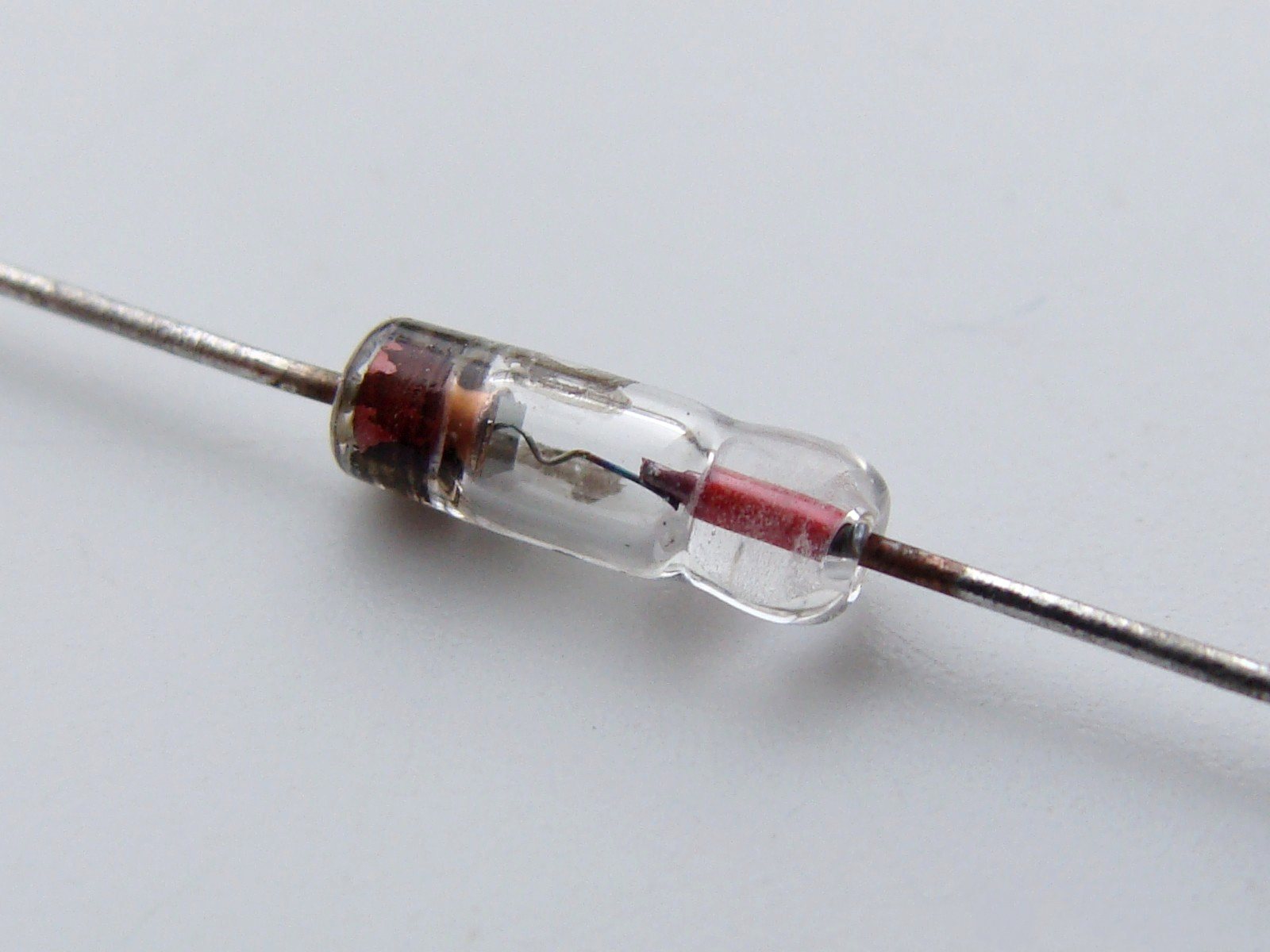
Germanium Diode 1n60
Guitar distortion is obtained and shaped at various points in the signal processing chain, including multiple stages of preamp distortion, power valve distortion, output and power transformer distortion, and guitar speaker distortion. Much of the distortion character or voicing is controlled by the frequency response before and after each distortion stage.
This dependency of distortion voicing on frequency response can be heard in the effect that a wah pedal has on the subsequent distortion stage, or by using tone controls built into the guitar, the preamp or an EQ pedal to favor the bass or treble components of the guitar pickup signal prior to the first distortion stage. Some guitarists place an equalizer pedal after the distortion effect, to emphasize or de-emphasize different frequencies in the distorted signal.
Increasing the bass and treble while reducing or eliminating the centre midrange (750 Hz) results in what is popularly known as a "scooped" sound (since the midrange frequencies are "scooped" out). Conversely, decreasing the bass while increasing the midrange and treble creates a punchy, harsher sound.
Shortly thereafter, the American instrumental rock band The Ventures asked their friend session musician and electronics enthusiast Orville "Red" Rhodes for help recreating the Grady Martin "fuzz” sound. Rhodes offered The Ventures a fuzzbox he had made, which they used to record "2000 Pound Bee" in 1962. The best-known early commercial distortion circuit was the Maestro FZ-1 Fuzz-Tone, manufactured by Gibson, released in 1962.
Also in the early 1960s, surf rock guitarist Dick Dale, who produced hits such as "Let's Go Trippin'" (1961) and "Misirlou" (1962), worked closely with Fender to push the limits of electric amplification technology, producing the first 100-watt guitar amplifier.
Guitar amp modeling devices and software can reproduce various guitar-specific distortion qualities that are associated with a range of popular "stomp box" pedals and amplifiers. Amp modeling devices typically use digital signal processing to recreate the sound of plugging into analogue pedals and overdriven valve amplifiers. The most sophisticated devices allow the user to customize the simulated results of using different preamp, power-tube, speaker distortion, speaker cabinet, and microphone placement combinations. For example, a guitarist using a small amp modeling pedal could simulate the sound of plugging their electric guitar into a heavy vintage valve amplifier and a stack of 8 X 10" speaker cabinets.
In 1964, a fuzzy and somewhat distorted sound gained widespread popularity after guitarist Dave Davies of The Kinks used a razor blade to slash his speaker cones the band's single "You Really Got Me".
In May 1965 Keith Richards used a Gibson Maestro FZ-1 Fuzz-Tone to record "(I Can't Get No) Satisfaction". The song's success greatly boosted sales of the device, and all available stock sold out by the end of 1965.
Maestro’s Fuzz-Tone 1963
Other early fuzzboxes include the
Mosrite FuzzRITE and
Arbiter Group Fuzz Face 1966
the Electro-Harmonix Big Muff Pi
used by Hendrix and Carlos Santana,
and the Vox Tone Bender
used by Paul McCartney to play fuzz bass on "Think for Yourself" and other Beatles recordings.In 1966, Jim Marshall of the British company Marshall Amplification began modifying the electronic circuitry of his amplifiers so as to achieve a "brighter, louder" sound and fuller distortion capabilities.
In the late 1960s and early 1970s hard rock bands such as Deep Purple, Led Zeppelin and Black Sabbath forged what would eventually become the heavy metal sound through a combined use of high volumes and heavy distortion.
SOURCES
